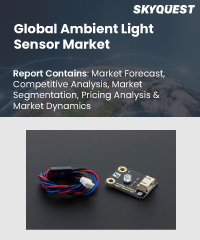
Report ID: SQMIG45J2201

Report ID:
SQMIG45J2201 |
Region:
Global |
Published Date: February, 2024
Pages:
197
|
Tables:
64 |
Figures:
74
Drivers
Increasing Demand for Consumer Electronics
Our analysis reveals that the burgeoning demand for consumer electronics is a significant driver for the ambient light sensors market. In recent years, there has been a marked increase in the adoption of smartphones, tablets, laptops, and smartwatches. These devices heavily rely on ambient light sensors to adjust screen brightness according to surrounding light conditions, thereby enhancing user experience and optimizing battery life. The proliferation of smart homes and the Internet of Things (IoT) has further augmented the need for these sensors in devices such as smart lighting systems, security cameras, and home automation products. The integration of ambient light sensors in wearable technology, which is gaining popularity for health and fitness tracking, also contributes to market growth. Furthermore, advancements in sensor technology, leading to more compact and efficient sensors, are enabling their integration into a broader range of consumer electronics. The growing consumer preference for energy-efficient and user-friendly devices is likely to sustain this demand, driving continuous innovation and expansion in the ambient light sensors market.
Growth of Automotive Industry and ADAS technology
Our analysis reveals that the automotive industry's evolution, particularly the advancement of Advanced Driver Assistance Systems (ADAS), is another key driver for the ambient light sensors market. Modern vehicles are increasingly equipped with sophisticated sensor systems to enhance safety and driving comfort. Ambient light sensors play a critical role in adjusting the brightness of interior and dashboard lighting, as well as in automatic headlight control systems, ensuring optimal visibility under varying lighting conditions. The surge in demand for electric and autonomous vehicles, which require advanced sensing capabilities, further fuels the need for ambient light sensors. Additionally, stringent government regulations aimed at improving road safety and reducing accidents are pushing automotive manufacturers to incorporate more advanced sensor technologies. The rapid technological advancements in the automotive sector, combined with consumer demand for enhanced safety features, are expected to drive substantial growth in the ambient light sensors market.
Restraints
High Manufacturing Costs
Our analysis found that a major threat in the ambient light sensors market is the high cost of manufacturing including raw materials and other components. The making of ambient light sensors require precision in their fabrication and the incorporation of high technologies and materials, and therefore expensive. Also, the costs of manufacturing the sensors are high due to the need to ensure the accuracy and reliability of the sensors hence the need to incorporate quality checks measures into the manufacturing process. Such costs of production as those aforementioned have the effect of directly influencing the final cost per unit and thus restricting the market absorption capacity mainly in the B2C markets like the consumer electronics market. In addition, subsequent technological improvements of various sensors always require R&D to incorporate them into production, which forms another barrier to costs. These high costs are a disadvantage because the entry barriers they set high for new players in the market and can limit the growth strategies of current market players. Thus, the high manufacturing costs remain one of the major limitations to the market adoption and development of the ambient light sensors in different applications.
Regulatory and Compliance Challenges
Another key challenge incorporated with the market is regulatory and compliance factors that can hinder the growth of the ambient light sensors market. They are a factor that can act as a challenge since the regulatory standards of electronic devices and sensors are very tight. These regulations frequently differ across regions and therefore put the companies in the dilemma of which regulations to adhere to. Adhering to these regulations could be very demanding as it requires the products to undergo severe testing and certification. For instance, EMC and RoHS directive in EU that require investing a lot on testing and certification. Failure to adhere to these regulations may attract stiff penalties, the company’s products may be recalled from the market and this will have long-term impacts on the company’s market presence and profitability. Also, high variability of regulations can also be a problem as it makes manufacturers change products often so that they meet the existing standards.
Our industry expert will work with you to provide you with customized data in a short amount of time.
REQUEST FREE CUSTOMIZATIONWant to customize this report? This report can be personalized according to your needs. Our analysts and industry experts will work directly with you to understand your requirements and provide you with customized data in a short amount of time. We offer $1000 worth of FREE customization at the time of purchase.

Report ID: SQMIG45J2201